Armour Straight to the beaches: LSTs
For this first crossover article with our sister website, tanks encyclopedia, meet the ships that really allowed to carry allied armoured divisions straight to the beach of Italy, France, or many Pacific Islands. Without these, and because of devastated, fortified or absent harbours, tanks would have to wait long after the troops have landed before any infrastructure was ready for them. Those troops then would have been deprived of a very essential tool in modern warfare, impending heavy losses or to be pushed back to the sea.
An introduction: Heavy Landing ships in history
Beach landing operations were nothing new in the XXth century: In the Greek classical and Roman eras, Polybius, Thucydides, Livy, Demosthene and Diodorus all described the Hippagoges, ships tailored to carry horses. In the late Roman era were mentioned the “Thýra-Khelandions”.
We already know the Byzantines introduced the “Greek Fire”, a heavy napalm thrower/flamethrower. They also used heavy galleys tailored to carry cavalry (A. Jal, Archeologie Navale, 1840). What we don’t know however were the details of their use or configuration.
Did the horses were stored above the rowers ?. Did the horses disembarked directly from frontal hinged doors as it supposed to sound ? Any case, this kind of ship was again described as the “nef huissière” in the Crusades (Hippagines Naves). These ships rigged the latin way (with triangular sails) and had rear doors to left the horse enter. But they probably required wooden ramps to allow the horse to disembark, or from side doors on wharves. This was the norm in conventional landings, after the infantry effectively beach landed on small rowing boats and already secured a solid foothold, up to the Crimean war.
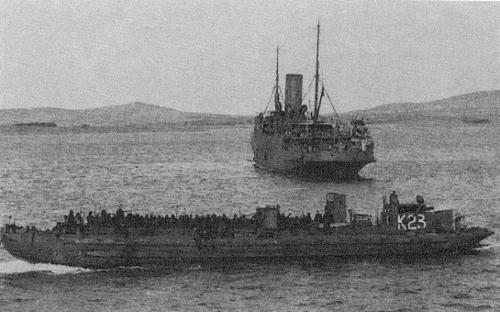
WW1 British X-Type landing craft
However, already in 1879 for the landing in Pisagua, the Government of Chile ordered to built flat-bottomed landing craft called Chalanas. These had all the attributes of modern landing crafts and were large enough to a sizable infantry, landing some 1,800 men in less than two hours. In WW1, at Gallipoli, it was back to the usual, improvised methods with infantry landing from rowing ships. Horses and a few vehicles arrive much later when a wharf was constructed. In some occasions, troops that were leaving a ship via side doors were moaned down by Turkish shore defenses.
Landing ships of the the Great War
Only in February 1915 was placed an order for a purposely-designed landing craft. No less than 200 ‘X’ Lighters with a spoon-shaped bow were built. Their first tour of duty was in the Aegean coast of the Gallipoli peninsula. With their drop down frontal ramp they landed the entire IX Corps (Commander Edward Unwin) at Suvla Bay, 6 August 1915, removing the Turkish Garrison. Known as the ‘Beetles’, these 135 tonnes ships carried 500 men each, and where 105’6” long, 21′ wide, and 7’6” deep (32.2 m × 6.4 m × 2.3 m), all with bulletproof sides. Their heavy oil engines gave them 5 knots (9.3 km/h; 5.8 mph).
Interwar Prototypes
For tanks, there were already projects to land British heavy tanks from pontoons at the 3rd battle of Ypres in late 1917. In the interwar, prospects were renewed, at least in the British Navy to carry and land medium tanks. Exercises took place, in which a prototype designed by J. Samuel White of Cowes, was first tested in 1926. This relatively small craft was boxy in appearance, 16 tons, with a flat bow and stern. It was propelled by a a crude waterjet fed by a centrifugal pump driven by a Hotchkiss petrol engine. Eventually three were operated in 1930.
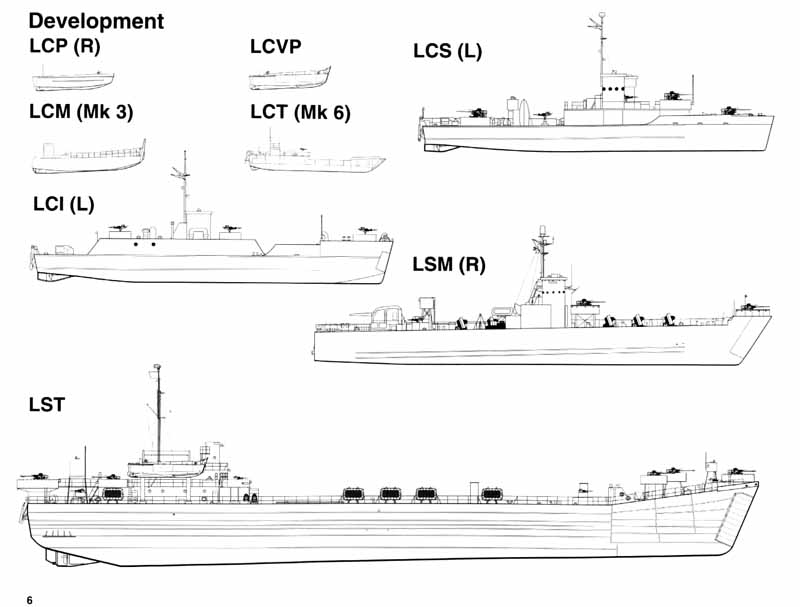
US Landing Ship/Caft family
Early Wartime Landing Ships
Back in USA, both the USN and USMC studied the concept of advanced base force, which officially evolved into the Fleet Marine Force (FMF) in 1933. Fleet Landing Exercises took place in 1939 in which Andrew Higgins’s boats for the first time shown their capabilities. The final design was given a ramp, was named LCVP, and mass production started right away. But these crafts were infantry-carrying ones.
A slightly larger variant called the LCPR could carry a jeep. But for larger hardware, converted cargos became the norm, including those mass-built to replace the losses in the Atlantic (Liberty ships among others). In the meantime larger infantry-carrying ships like the LSI appeared, and the first vehicles-carrying ones. The first were the Landing Craft Mechanized (LCM) series devised two years earlier, and operated by the Royal Navy.
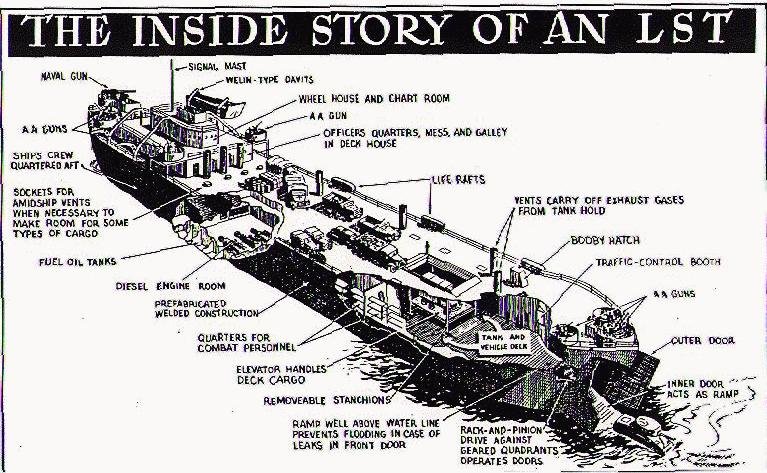
Wartime LST description
The LST concept
The real incentive began when Prime Minister Winston Churchill demanded an amphibious vessel capable of landing at least three 36-ton heavy tanks directly onto a beach in 1940. It was to be seaworthy and capable of a 10 day cruise in high seas, be inexpensive and simple to maintain. Naval architect Sir Roland Baker essentially designed what became the LCT Mark I, a 372 tonnes ships launched by Hawthorn Leslie in November 1940.
It was followed by three series, until the larger Mark 4, tested in combat in the disastrous Allied raid on Dieppe in 1942, the experience of which was closely followed by the personal in charge of the design of an equivalent for US service.
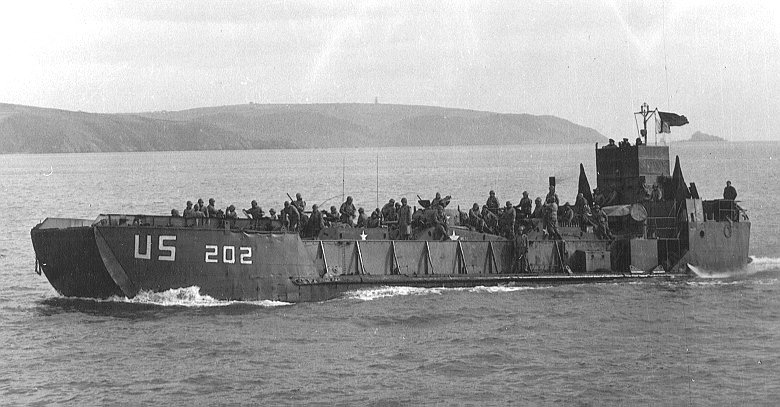
British LCT 202.
After December 1941 indeed, the Bureau of Ships was put in charge to design plans for a ship which integrated advices from K.C. Barnaby of Thornycroft which worked on previous LCTs. Also the British evacuation from Dunkirk in 1940 was another motivation to study such designs. Early 1942, the first design was the LCT Mark 5, a 117-foot (36 m) craft, and it was possible to carry and ship it to combat in three separate water-tight sections, on board cargo ships of even an LST.
The Landing Ship, Tank however was a much larger design which can carry and extensive payload for amphibious operations. The real challenge was to go from the known working behaviour of a nimble landing craft, to such behemoth capable to deliver entire armoured battalions. The LST was a true game changer as it was not carried from a mothership but capable of ocean-going, shore-to-shore landings, almost from the training camp to the frontline.
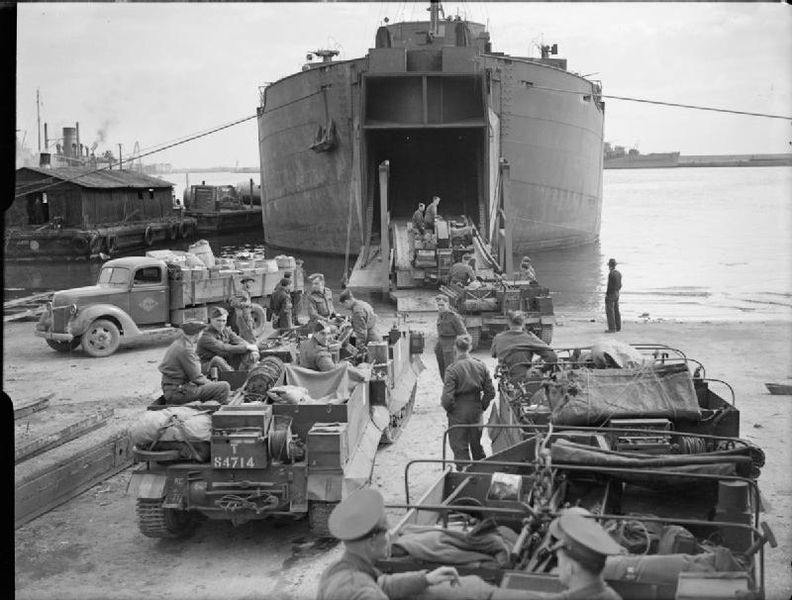
HMS Bachaquero at Bone, 1942
Development of the LST
The fist true LST was British, the HMS Boxer class (Boxer, Bruiser, and Thruster, ordered in March 1941). It was capable to deliver 13 Churchill heavy infantry tanks, 27 vehicles and nearly 200 men, all across the ocean at a speed of 18 knots. However as it could not have shallow draught each of the three ships (March 1941) were given a very long ramp, stowed behind the bow doors. In November 1941, a British delegation paid a visit to the US United States Navy’s Bureau of Ships for future shared development and also passed their experience to the new design.
The latter, called The LST(2) integrated among other ideas from Sir Rowland Baker’s experience with LCTs, and the design was eventually authorized by the Congress in the acts of 6 February 1942, 26 May 1943, and 17 December 1943 as the same time as an enormous shipbuilding programme, unprecedented in US History. The keel of the first LST was laid down on 10 June 1942 at Newport News.
Standardization came in October, and twenty-three were in service by the end of the year. From then on indeed, a staggering quantity would be built until the end of the war, at breakneck speed, so much so that the admiralty did not even bother to give them proper names. They received identification numbers like all other landing crafts in service…
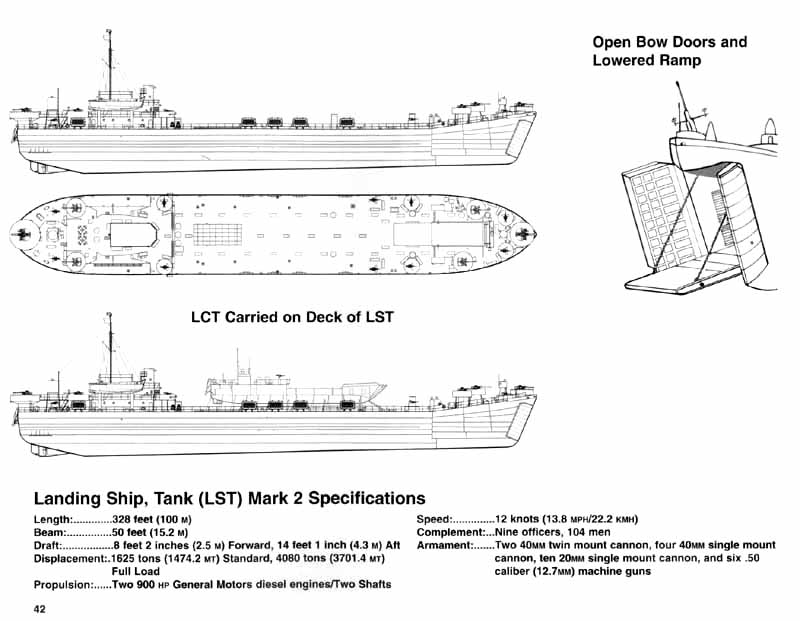
LCT-LST blueprint
Design Development of the LST(2)
Initial specification asked sufficient inner buoyancy even when the tank deck was flooded. Top speed was 10 knots as designed, with the same load as the HMS Boxer but drawing only 3 feet forward when beaching. These very large landing ships (at least until the modern assault ships built in the 1960s) were nevertheless challenging for engineers.
They had to retain qualities of long cruise ocean-going cargo ships, while being able to not only land hardware on the beach, but also retreat by themselves at sea to take another load, performing vital and relentless rotations from shore-to-shore all along the ongoing amphibious operations. For a start, a flat-bottom ship was a nuisance at sea, especially with a shallow drought.
In bad weather, if the excessive roll and pitch was not enough to have everyone on board sea sick to death, the stress on the hull would have gone far enough to break it apart. The problem was eventually solved by John C. Niedermair of the Bureau of Ships.
He basically sketched out the basic design that was to be standardized, which integrated an ingeniously large ballast system, filled for ocean cruise, and pumped out for beaching operations. The second ace in his sleeve was the equally ingenious, massive anchor and mechanical winch system which allowed the ship to pull itself off the beach, ensuring another rotation.
At that time, the US were not at war yet and the design was submitted to the British Admiralty on 5 November 1941, immediately accepted. An order came in response for 200 “LST (2)” or Mark 2 to be built through Lend-Lease. Of course one month later, the USA went at war, and this altered and accelerated the process that followed.
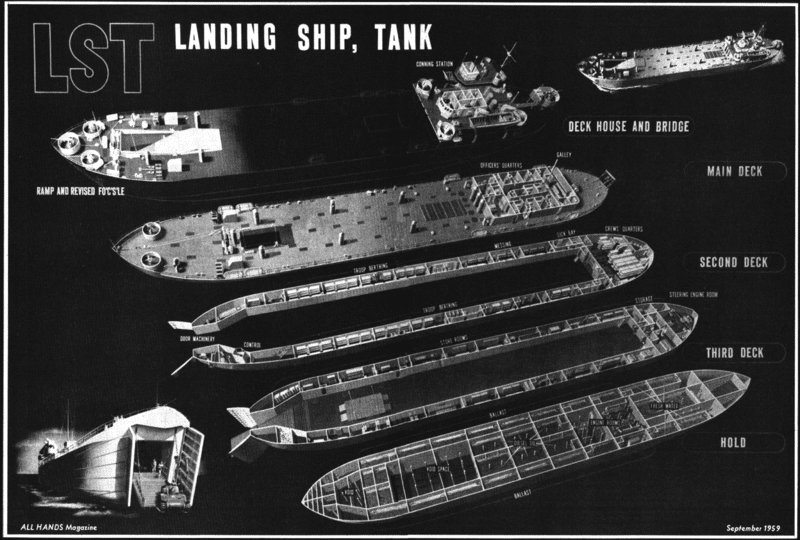
LST cutaway ad technical overview
Indeed in January 1942 the initial LST 280 feet (85 m) plan was modified as the Bureau of Ships asked for a 290 feets ship, and before the end of the month settled on a 328 feet (100 m) ship, that has to be given also a 50-foot (15 m) beam. These generous dimensions were not only motivated by payload concerns but also to ride higher in the water.
Their carrying capacity was nevertheless taken to 2,100-ton (1,900 t) and the larger width allowed to design a more generous bow door opening and ramp of 14 feet (4.3 m), large enough to accommodate all allied vehicles in service. The larger size also imposed thicker plates, 0.375 inches (9 mm) on the bridge, but not hardened, which did not constituted a true protection against shell splinters. The bow under plates were one inch thick to absorb beaching stress. A scale model was produced and tested at the David Taylor Model Basin in Washington, D.C.
Design Specifications
In addition of the ballasts, anchor and winch systems, many other details were worked out, like the ventilation of the tank space, which provided enough draft to allow all tanks to start and warm their engine before landing. A small elevator was also provided to store additional vehicles and payloads on the upper deck. In April 1942 a mock-up well-deck was built and tested for three monthes in real conditions with tanks supplied by Fort Knox (at this location). First beaching test was performed at Quonset, Rhode Island, in early 1943.
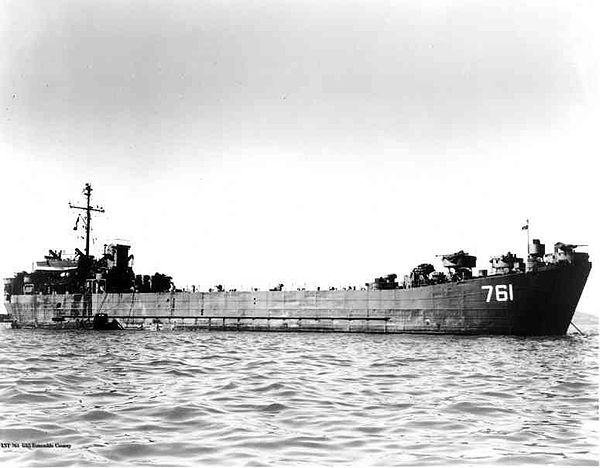
LST-761
Production
Standardization came in October 1942, although production was well underway already. What was particular in that case it that production plans commenced even before testing were completed, or even scheduled. Coordination between the Bureau of Ships and shipbuilders was performed on the flow by the Material Coordinating Agency, allowing flexibility and revisions during the initial production phases.
The programme indeed had received the utmost urgency. The keel of an aircraft carrier was even removed to make room for the first LST. The flat-bottom of the ship allowed to built it along inland waterways, near the steel fabrication yards and supplies. Empty hulls were then often shipped and the operations surveyed by a “Ferry Command” to the coastal yards for completion and fitting-out of the equipments. Remarkably enough, of the 1,051 LSTs built during the war, 670 were supplied by five “cornfield shipyards” in the Middle West !
These were Neville Island, and the American Bridge Company in Ambridge, Pennsylvania, Missouri Valley Bridge & Iron Co. in Evansville, Indiana, Chicago Bridge and Iron’s shipyard in Seneca, Illinois.
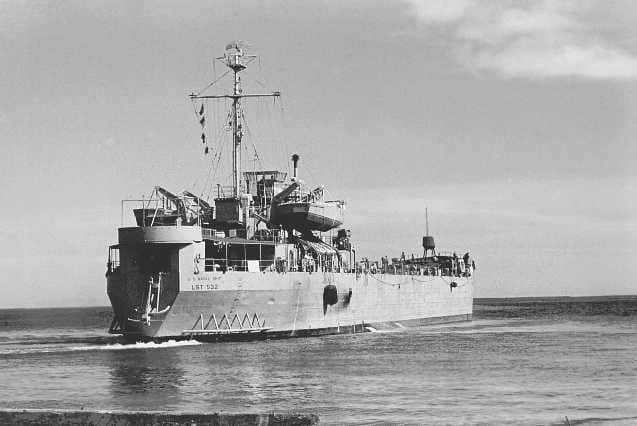
LST-532
Production simplifications were ongoing constantly to provide faster paces in welding and assembling, so much so, that from the initial four monthes in 1943 the production was reduced down to two monthes. But in between, operational experience had a return and imposed substantial modifications.
From LST-491, the elevator was replaced by a hinged ramp lowered to the main deck, placed just before the the bow ramp, allowing much faster rolling operations and landing. From the LST-542 class was added a navigation bridge, water distillation plant, removal of the tank deck ventilator from the main deck and strengthening of the main in order to carry a LCT, an upgrade in armor and the addition of a 3 in caliber gun.
They had two General Motors 12-567 diesel engines, two shafts, twin rudders and a Speed of 12 knots (14 mph; 22 km/h). When submerged, the main bay could accomodate 2 to 6 LCVPs. Eventually 1,051 has been actually constructed, 113 LSTs were transferred to Britain, and four found their way later in the Greek navy (see later).
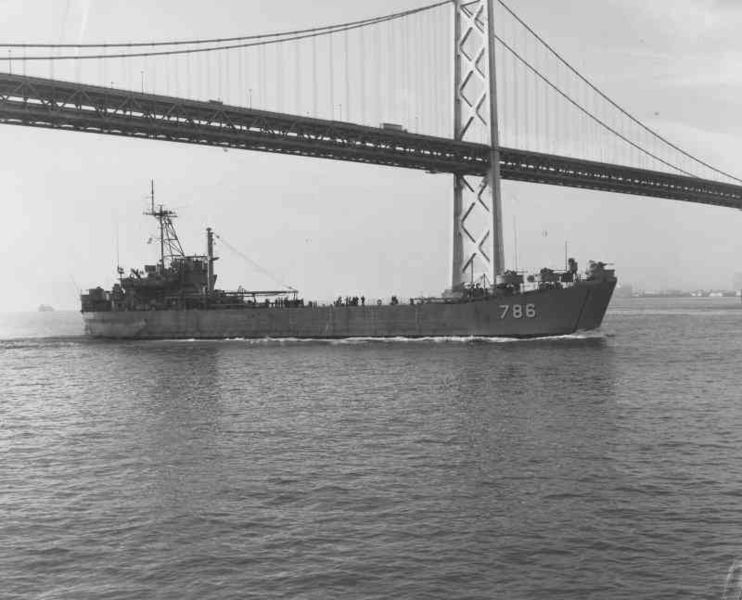
LST 786
British LSTs
Although this would be the object of a separated article, some 80 LST Mk.3 (40 cancelled) were built in the UK (35) and Canada (26). They served with marines as diverses after the war as the Royal Australian Navy, Hellenic Navy, Royal Netherlands Navy, Indian Navy. Propulsion was assumed by an Admiralty pattern 3-drum water-tube type boilers (225 pounds psqi).
Main engines were 4-cylinder triple expansion, 4-crank type, balanced on the Yarrow-Tweedy-Slick system. Thy developed 2,750 hp (2,050 kW) total. In addition there were the three initial massive ships, 116 m long, 4800 tonnes Maracaibo class. These signaled themselves by their double hinged ramp of 100 ft (30 m) span and could carry 18 × 30 ton tanks or 22 × 25 ton tanks or 33 × 3-ton trucks. The Boxer class was even larger at 120 m and 5400-5900 tonnes.
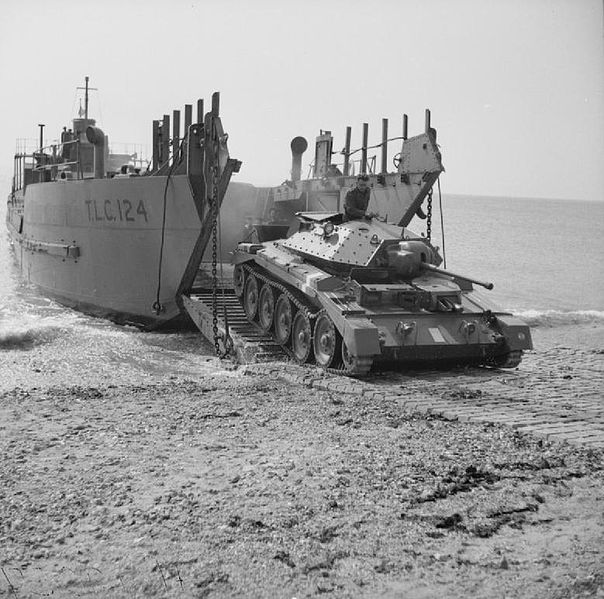
A Crusader tank landing from LCT-124
The LST in action
Unfortunately despite their merits (Winston Churchill would claim later that these workhorses “won the war” for the allies), the LST were not so quite vulnerable despite been quickly nicknamed both the sailors and soldiers “Large Slow Target” or “Large Stationary Target” from their acronym.
Their combat debut took place in the Solomon Islands in June 1943 (and not Operation Torch as generally thought were converted ships and LCTs were present). They participated in the invasions of Sicily (Operation Husky), Italy (Baytown, Avalanche), Normandy (Overlord), Southern France (Anvil Dragoon) in the European Theater and proved invaluable in the whole island-hopping campaigns in the Pacific. They had been instrumental in the Philippines, Iwo Jima and Okinawa.
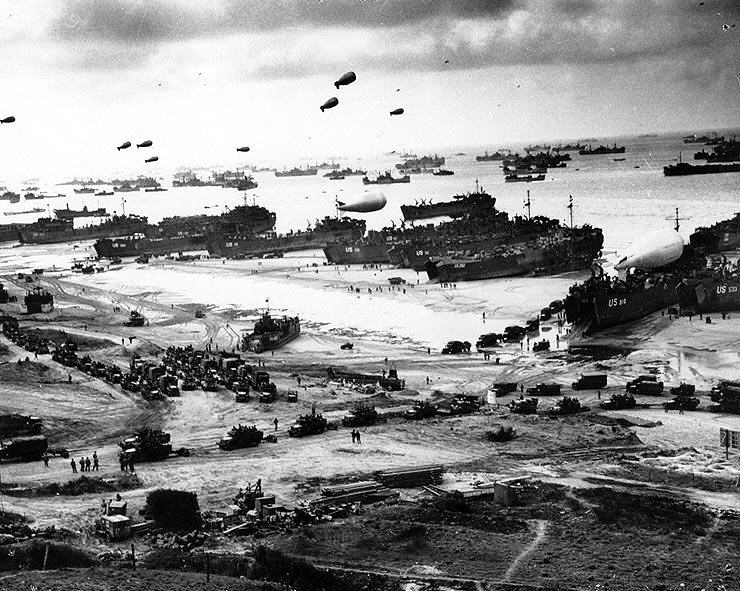
LSTs in Normandy, june 1944
Even with such production however, they were never enough of these ships for the Mediterranean theater or to assume the logistics of amphibious operations in Italy, but after the landings in Normandy, the situation gradually improved. LSTs suffered losses in several occasions, notably a devastating ammunition supply mishandling that cost a chain explosion.
These ships could nevertheless absorb punishment and survive, possibly because of their reinforced structure. One survived a collision with a Liberty Ship.
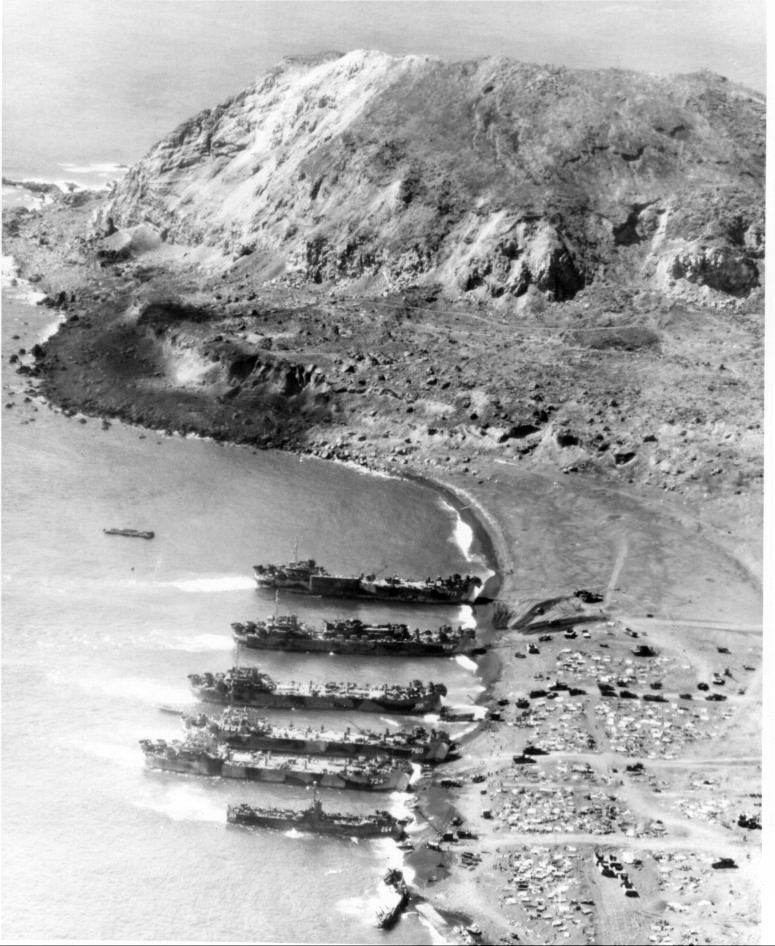
LSTs at Iwo Jima, with mount Suribachi behind
Only 26 were lost due to enemy action, 13 more because of bad weather, reef, or accidents. Better still, of the grand total, if many had been mothballed, other scrapped or tested in a nuclear explosion, the majority served yet again in the Korean war, proving themselves at the landing in Inchon, and were later modernized, to served in the Vietnam war (at last named after Counties and Parrishes), despite their age.
Also as a side note, LST were not the largest amphibious ships built in WW2: The LSVs of 6000 tonnes with an aft ramp to carry DUKWs, LVTs, LCVPs or LVTs depending of the operations (6 built, 1942-43) or the twenty-five, 4030/7400 tonnes LSDs (landing ships docks) which carried beaching crafts, pioneering the modern assault ships.
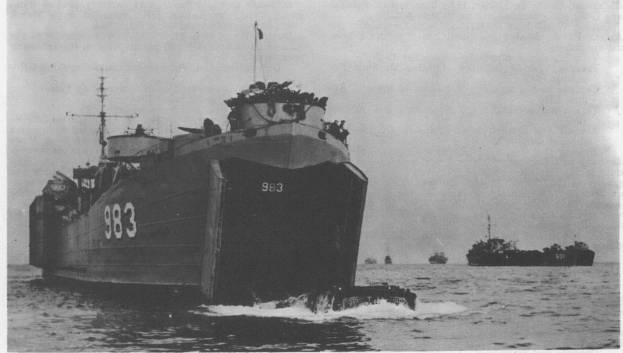
LST launching a LVTP-5
WW2 Veterans saved the last LST
In the US, the last was sold for scrap in 1984. But those which served under foreign flags has been maintained in service for some well until the early 1990s. One of these, the Greek L144 in 1994 was one of four LSTs scheduled for replacement. A group of US Veterans deploring the absence of a surviving ww2-era LST battled for years with red tape and sent a delegation to evaluate the ships.
One (with the best-looking state) was chosen, anchored in Suda bay in Crete. It was repaired and restored, then undergone a perilous trip across the Mediterranean (yet with more repairs en route as one engine broke up), and then across the Atlantic and Mexican gulf to Mobile, Alabama, where it stands today in its original LST-325 ww2 state in working order, available for visits.
Conversions
In total 83 ships were converted as auxiliaries or special-purpose vessels.
-ARL (Landing craft repair ships): Bow ramp and doors removed and sealed, derricks, booms and winches added to haul damaged landing craft on board for repairs. Auxiliary power and electrical workshops were also provided.
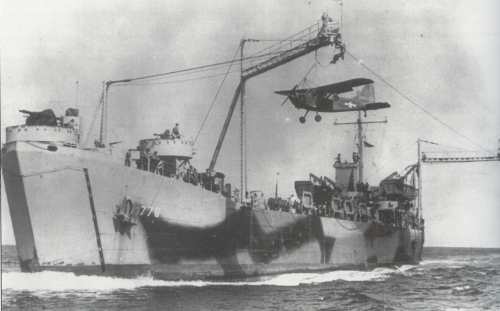
LST 776 with Brodie system
-LSTH (Landing Hospital ships): 36 converted. They brought no less than 41,035 wounded men back across the English Channel from Normandy by D-Day+114 (28 September 1944).
-Ammunition Supply Ships: Some were given extra cranes and handling gear, used only for ammunition supply for capital ships.
Improvized aircraft carriers: The USS LST-906 launched a L-4 Grasshopper from a prepared flight deck. While additional L-4s were stowed alongside the deck. Later in the war, USS LST-16, USS LST-337, USS LST-386, USS LST-525, LST-776, and USS LST-906 were all converted to launch planes only but USS LST-393 and USS LST-776 were fitted with the Brodie System for planes take off and landings.
FTD (Fighter Direction Tenders): Three converted in British service. they had AMES Type 11 and Type 15 fighter control radar to provide coverage and coordination on the D-Day landing areas (Despite Luftwaffe incursions were quite reduced). HMS FDT 216 covered Omaha and Utah beaches, HMS FDT 217 Sword, Juno, and Gold, and HMS FDT 13 covered the channel. They resulted nonetheless to the destruction of 76 enemy aircraft total.
Also some ships were converted as MTB tenders, aircraft engine or landing craft repair ships, battle damage repair ships, floating store and depot ships, salvage craft tenders.
Axis LSTs
It should be noted that the Japanese also devised their own LST for their operations, the T101 class delivered from 1943 to 1945. They have been planned by the Navy Technical Department (Kampon) after studying intelligence reports on the LCTs during operation Torch.
The first No.101 was laid down in November 1943. 103 were planned, and 69 completed (49 for the Navy, 20 for the Army) and 41 lost in action. They have about the same characteristics with a well deck but were lighter at 950 tonnes and 80.50 m (264 ft 1 in) long overall.
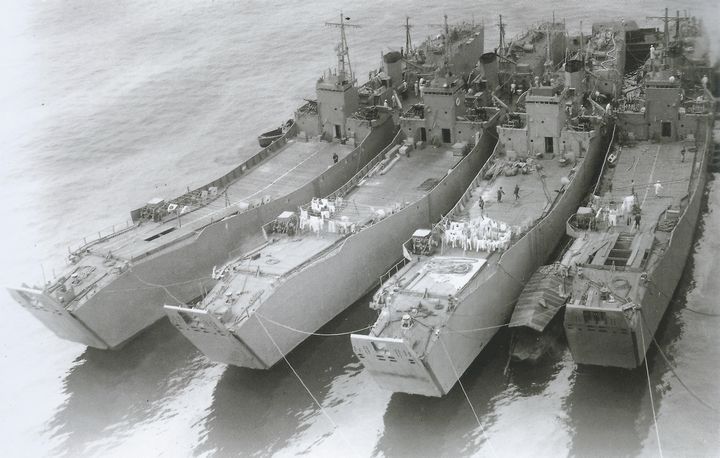
Japanese T101 type LSTs
The Germans also developed their own large landing ship, the Marinefährprahm (MFP), “naval ferry barge” in 1940, originally planned to participate in Operation Sea Lion (The British Invasion). Instead, these relatively smaller ships (220-239t, 47.04-49.84m long) has been mostly used in the Mediterranean theater, and in Norway, for auxiliary duties.
Some has been specialized as FLAK-ships, support ships and gunboats, referred to by the allies as the “Flak Lighter” or “F-lighter”. No less than 700 has been cranked up. They had a covered bridge and could carry light vehicles and about 200 men, but not tanks in the basic version. The A1 however was modified to carry captured and modified KV-1/K-2 tanks bound to invade Malta. The derived Italian Motozattera (MZ) planned for the same operation were modified to carry up to three M13/40 medium tanks and 100 fully equipped infantrymen.
Probably the most amazing tank landing ship ever imagined was the German Transport Hydrofoil VS-8, but that’s another story…
Visit of LST 325
Links
The LST series class on wikipedia
Full list of LSTs
Various liveries
3d model
Interesting paint scheme
On passionmilitaria.com (FR)
Specs Conway’s all the world fighting ships 1922-1946.
Standard 1944 LST specifications |
|
| Dimensions | 99,90 x 15 x 1.02-4.29 m (328′ x 50′ x 3′-14′) |
| Displacement | 1780 t standard – 3880 t FL |
| Crew | 108-125 |
| Propulsion | 2 screws, 2 TE 3 cyl., 12 boilers, 9775 cv. 19,3 knots max |
| Speed | 22 knots (40.7 km/h; 25.3 mph) |
| Range | 7,000 nmi (12,960 km; 8,060 mi) at 14 knots (25.9 km/h; 16.1 mph) |
| Armament | 1 × 3′ (76 mm), 6 × 40 mm, 6 × 20 mm, 2 × 0.5′ (12.7 mm), 4 × 0.3′ (7.62 mm) |
| Payload | 60 tonnes above deck, 2000 tonnes or 20 tanks & 200 men |
| Armor | 9.5 mm (0.37′) deck |
Video: LST documentary
Gallery
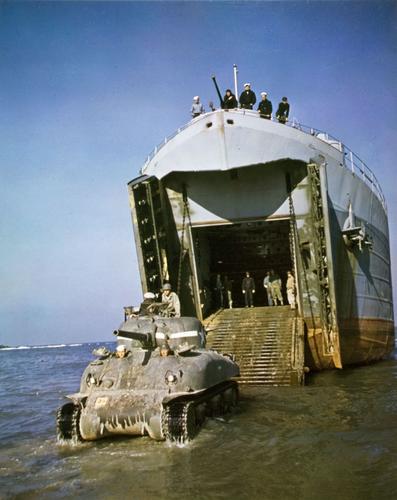
Sherman M4A1 landing off an LST in beaches of Anzio during the amphibious attack on German forces in Italy dubbed Operation Shingle – 22 January 1944
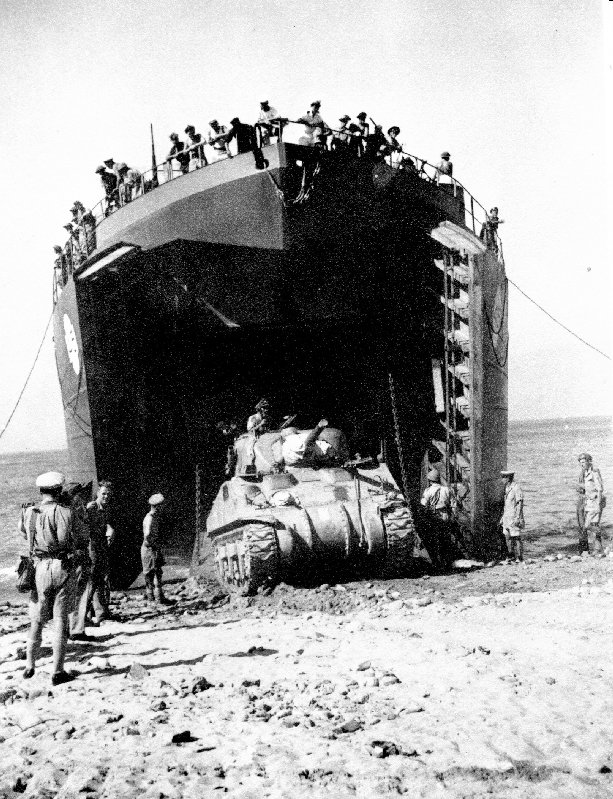
LST landing a Canadian Sherman tank in Sicily, 1943
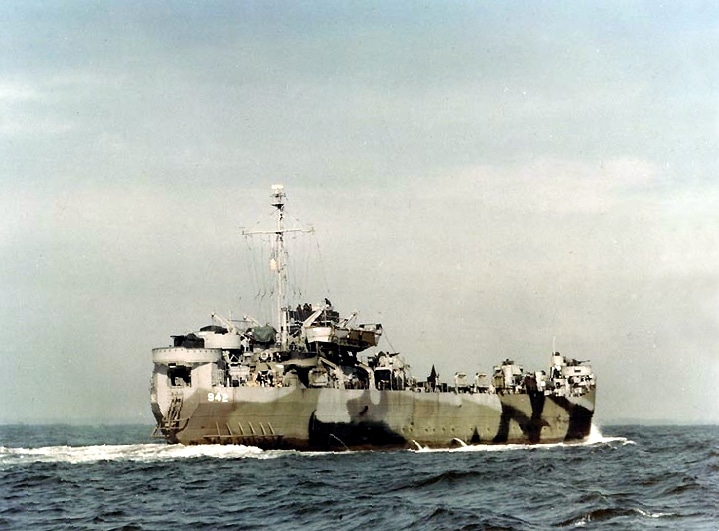
LST-942 underway in late 1944
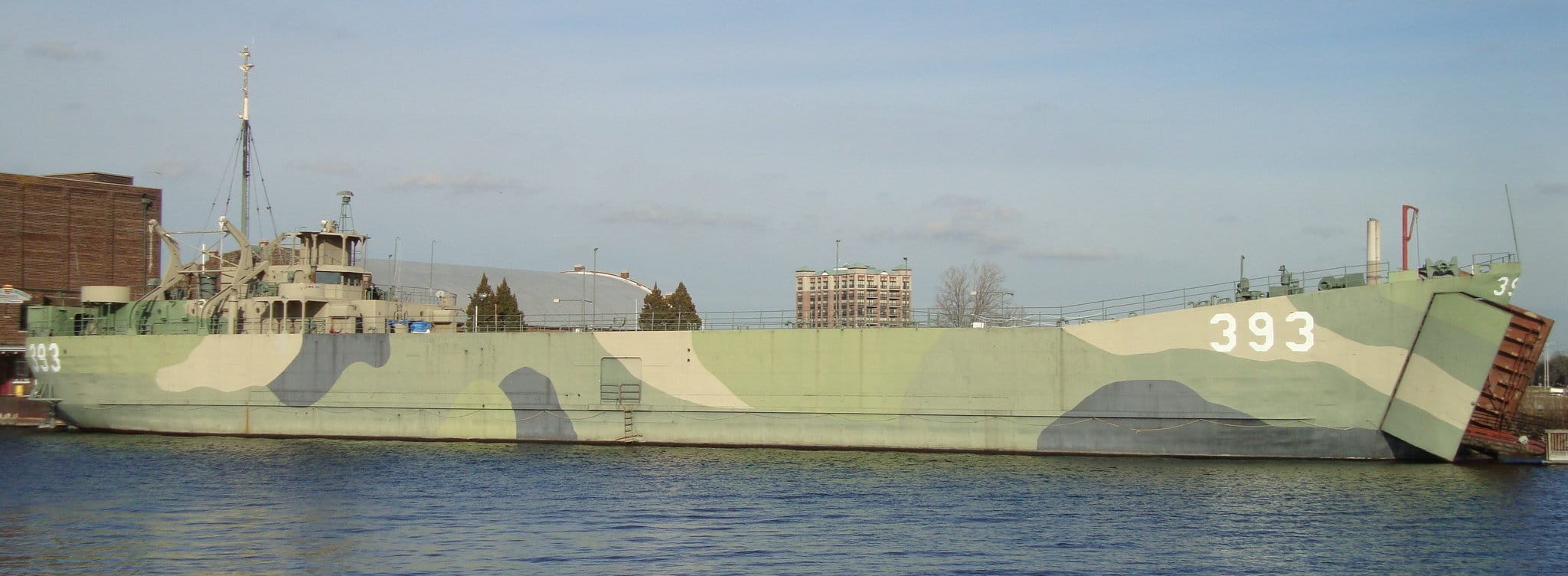
Camouflaged USS LST 393 at Muskegon in 2014 that Veterans wanted to repaint grey for 71st D-Day anniversary. The ship operated in North Africa, Sicily, Italy, England, Wales, Ireland and France, and was credited with carrying 9,135 soldiers and 3,248 vehicles.
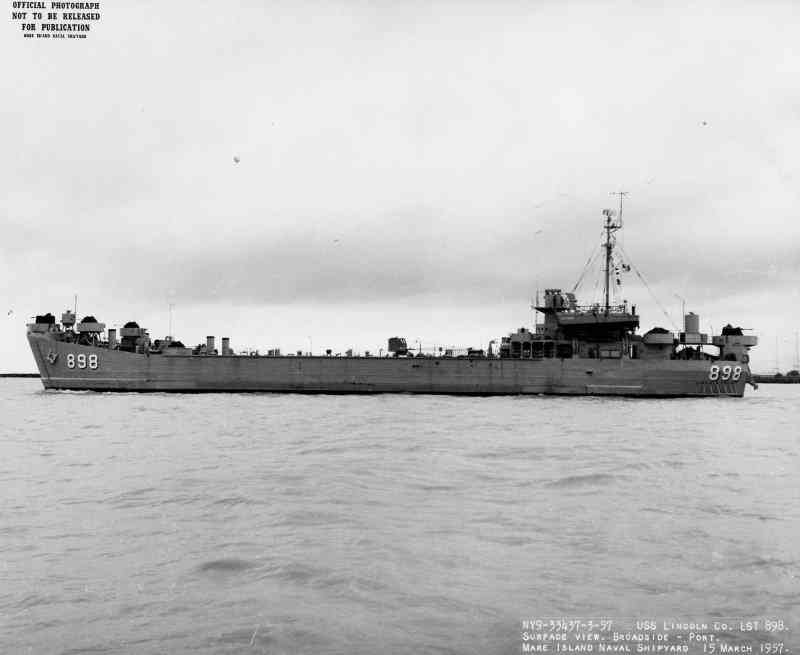
LST-598
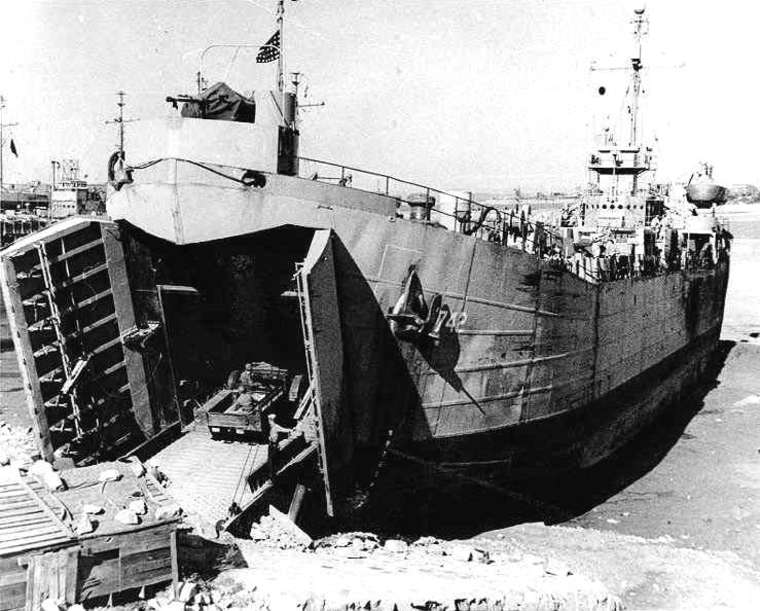
LST in operations
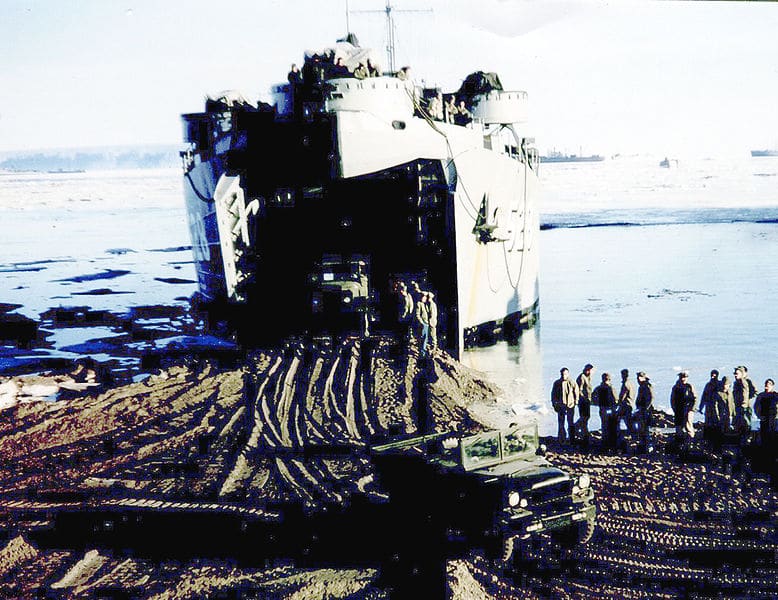
LST-528 at Thule in 1952
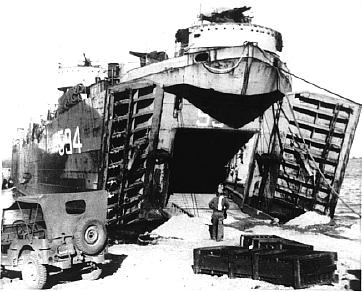
LST-594
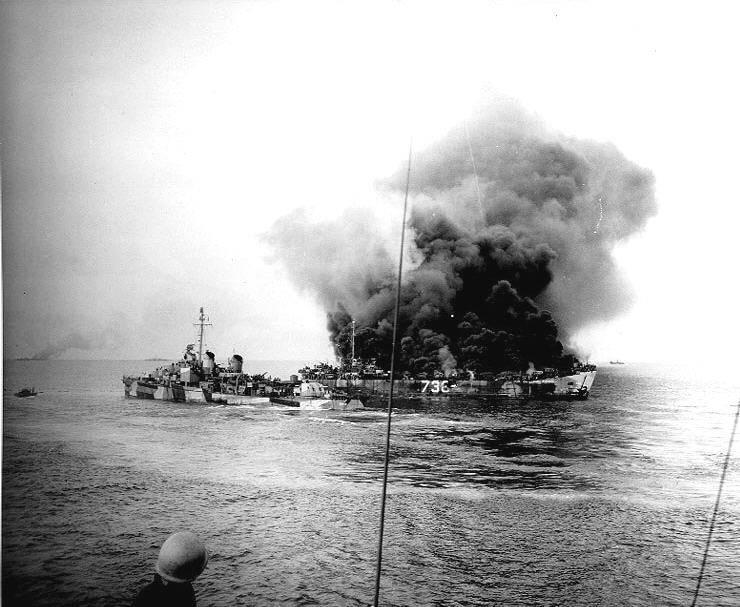
LST-738 burning after being hit by Japanese artillery
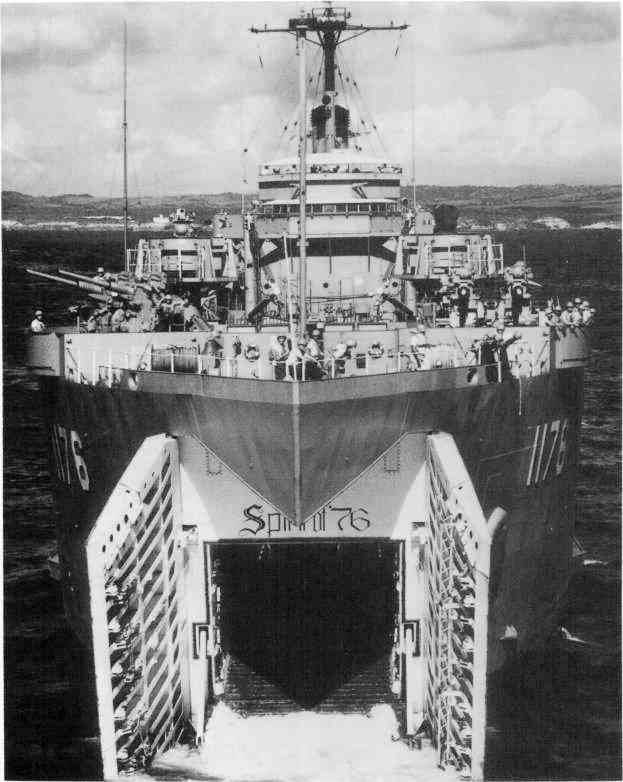
Modernized LST-1176 Graham County at Puerto Rico, 1964

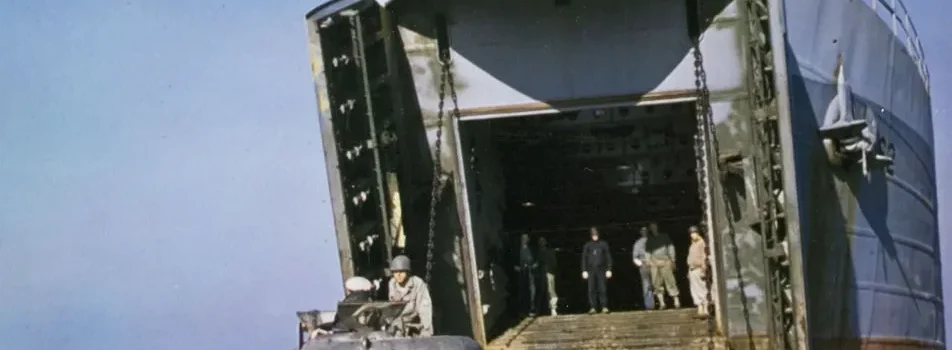



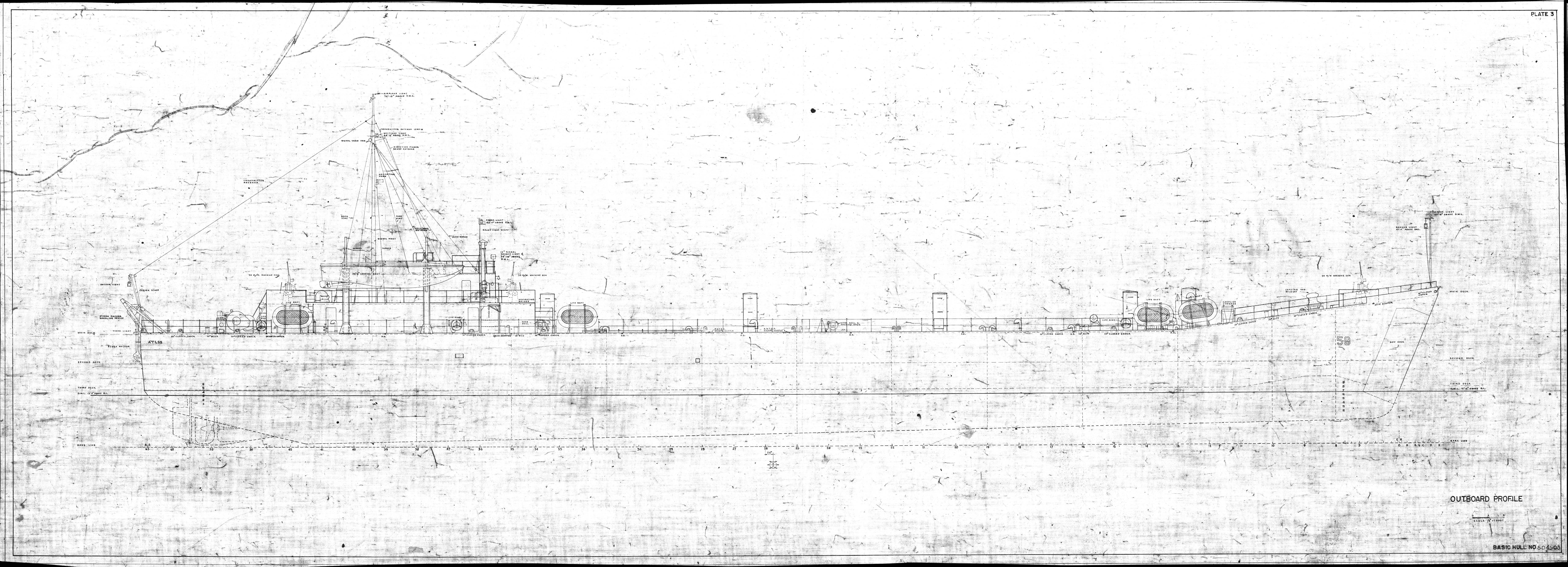
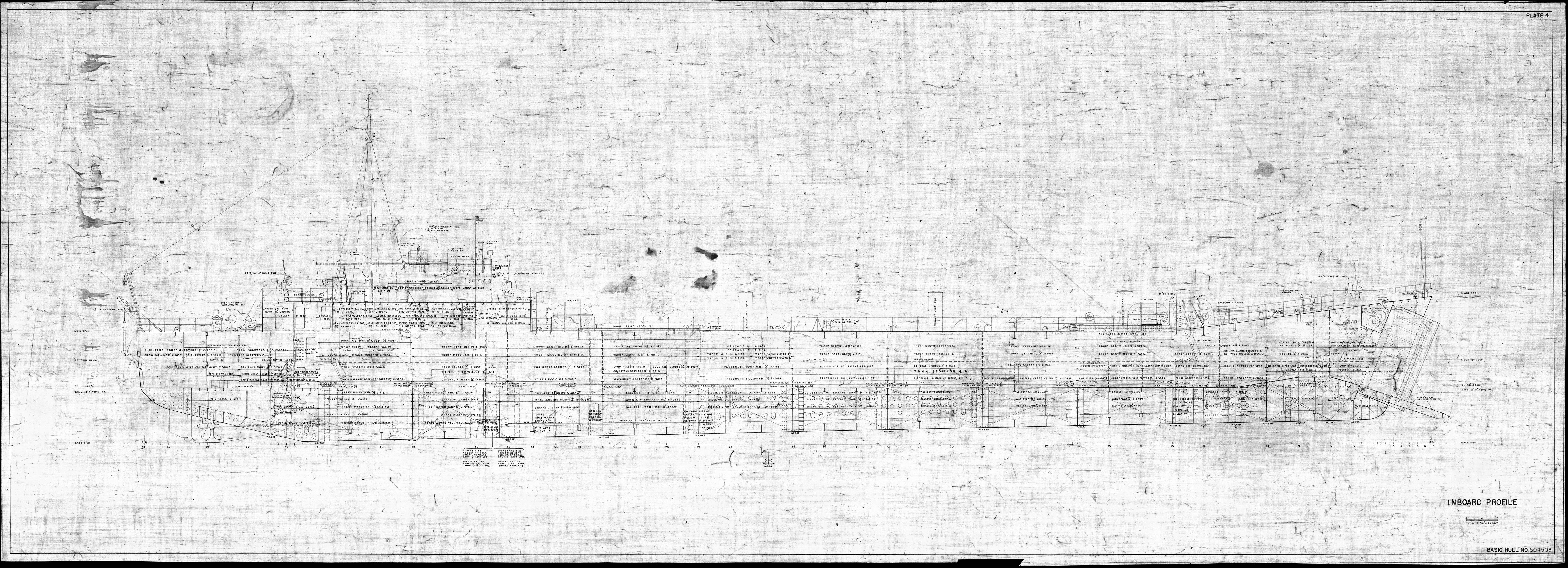






 Latest Facebook Entry -
Latest Facebook Entry -  X(Tweeter) Naval Encyclopedia's deck archive
X(Tweeter) Naval Encyclopedia's deck archive Instagram (@navalencyc)
Instagram (@navalencyc)





 French Navy
French Navy Royal Navy
Royal Navy Russian Navy
Russian Navy Armada Espanola
Armada Espanola Austrian Navy
Austrian Navy K.u.K. Kriegsmarine
K.u.K. Kriegsmarine Dansk Marine
Dansk Marine Nautiko Hellenon
Nautiko Hellenon Koninklije Marine 1870
Koninklije Marine 1870 Marinha do Brasil
Marinha do Brasil Osmanlı Donanması
Osmanlı Donanması Marina Do Peru
Marina Do Peru Marinha do Portugal
Marinha do Portugal Regia Marina 1870
Regia Marina 1870 Nihhon Kaigun 1870
Nihhon Kaigun 1870 Preußische Marine 1870
Preußische Marine 1870 Russkiy Flot 1870
Russkiy Flot 1870 Svenska marinen
Svenska marinen Søværnet
Søværnet Union Navy
Union Navy Confederate Navy
Confederate Navy Armada de Argentina
Armada de Argentina Imperial Chinese Navy
Imperial Chinese Navy Marinha do Portugal
Marinha do Portugal Mexico
Mexico Kaiserliche Marine
Kaiserliche Marine 1898 US Navy
1898 US Navy Sovietskiy Flot
Sovietskiy Flot Royal Canadian Navy
Royal Canadian Navy Royal Australian Navy
Royal Australian Navy RNZN Fleet
RNZN Fleet Chinese Navy 1937
Chinese Navy 1937 Kriegsmarine
Kriegsmarine Chilean Navy
Chilean Navy Danish Navy
Danish Navy Finnish Navy
Finnish Navy Hellenic Navy
Hellenic Navy Polish Navy
Polish Navy Romanian Navy
Romanian Navy Turkish Navy
Turkish Navy Royal Yugoslav Navy
Royal Yugoslav Navy Royal Thai Navy
Royal Thai Navy Minor Navies
Minor Navies Albania
Albania Austria
Austria Belgium
Belgium Columbia
Columbia Costa Rica
Costa Rica Cuba
Cuba Czechoslovakia
Czechoslovakia Dominican Republic
Dominican Republic Haiti
Haiti Hungary
Hungary Honduras
Honduras Estonia
Estonia Iceland
Iceland Eire
Eire Equador
Equador Iran
Iran Iraq
Iraq Latvia
Latvia Liberia
Liberia Lithuania
Lithuania Mandchukuo
Mandchukuo Morocco
Morocco Nicaragua
Nicaragua Persia
Persia San Salvador
San Salvador Sarawak
Sarawak Uruguay
Uruguay Venezuela
Venezuela Zanzibar
Zanzibar Warsaw Pact Navies
Warsaw Pact Navies Bulgaria
Bulgaria Hungary
Hungary

 Bundesmarine
Bundesmarine Dutch Navy
Dutch Navy Hellenic Navy
Hellenic Navy Marina Militare
Marina Militare Yugoslav Navy
Yugoslav Navy Chinese Navy
Chinese Navy Indian Navy
Indian Navy Indonesian Navy
Indonesian Navy JMSDF
JMSDF North Korean Navy
North Korean Navy Pakistani Navy
Pakistani Navy Philippines Navy
Philippines Navy ROKN
ROKN Rep. of Singapore Navy
Rep. of Singapore Navy Taiwanese Navy
Taiwanese Navy IDF Navy
IDF Navy Saudi Navy
Saudi Navy Royal New Zealand Navy
Royal New Zealand Navy Egyptian Navy
Egyptian Navy South African Navy
South African Navy






























 Ukrainian Navy
Ukrainian Navy dbodesign
dbodesign